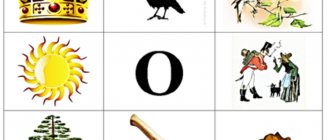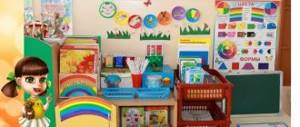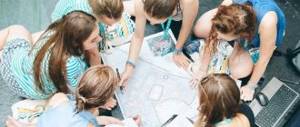Artistic development of preschool children in preschool educational institutions
Artistic and aesthetic education plays a special role in the life of a preschooler.
Important ! It is worthwhile to instill in a child a sense of beauty from early childhood and teach him to understand works of art.
Artistic education of children through the use of fine arts
The younger age of children makes them more receptive to the visual arts, which has a direct impact on artistic education. Artistic development is the ability to evaluate works of art, understand them, experience emotions from contact with them and create independently.
Kids need to be developed
It is important for preschoolers (preferably from the age of 1) to familiarize themselves with all types of fine arts as self-education:
- Sculpture is a work performed in volume in various ways.
- Painting is an image made with paints on a plane.
- Architecture - the creation of buildings and structures.
- Graphics is an image on a plane without color, using lines, strokes, and dots.
- Decorative arts are the decoration of something.
Children love paintings
It is also important to familiarize yourself with the various materials, of which there are different types:
- pencils;
- gel pens;
- ink and pen;
- gouache paints;
- watercolor;
- oil;
- acrylic;
- oil and dry pastels;
- coal;
- sanguine;
- markers;
- paper;
- clay;
- plasticine;
- marble;
- metals;
- glass;
- gypsum and many others.
Conditions for the successful development of a child’s visual activity
Artistic education is an integral part of human upbringing. The conditions for the successful development of a child’s visual activity include:
- Support by the teacher (in the absence of pressure on the process).
- Help in developing the imagination of a preschooler.
- Freedom to use materials for creativity.
- Awareness of the existence of various techniques and materials.
- Family assistance in the development of the child (family as a role model).
Kids love to decorate the kindergarten area
Aesthetic education in a kindergarten
Aesthetic education is designed to teach a preschooler:
- see beauty around;
- understand and appreciate art;
- reach for beauty.
The first place in aesthetic education in preschool educational institutions is occupied by the design of the territory of the kindergarten and its premises. This is the first thing a child sees when coming to kindergarten.
The area should be well-groomed, flowers should be planted in the summer, borders should be whitewashed, and garbage should be removed. The room where the group is located should not be cluttered, colorful or dark and gloomy.
It is important to maintain harmony in color; aesthetics is needed in the details. A library with beautiful illustrated books is needed in every group. Hanging reproductions of paintings or illustrations will be of great benefit.
Musical education of preschool children
Contemplation of nature is no less important. The teacher should teach this to the preschooler during walks. Example: pay attention to:
- insects (beautiful butterflies, hardworking ants, nimble dragonflies);
- dew on the grass;
- the first yellowed leaves;
- red bunches of rowan;
- early arrival of winter.
Note ! All this trains children's minds, develops their taste, and makes them more attentive.
We conduct a master class on artistic and aesthetic development
The master class “Swan Fidelity” (finger painting) will be useful.
Type: practical lesson.
Equipment: thick A3 paper, pencil, eraser, gouache, brushes, water jar, table.
Objective: to introduce preschoolers to a new drawing technique, to develop imagination and creativity.
Duration: one academic hour.
Progress:
- “Guys, you probably know about the existence of such birds as swans. They are very beautiful and graceful. They have a flexible, long neck. They come in white and black. They differ in that they create a pair for life. And if one swan dies, then the second may die of melancholy.”
- “Today we will draw a couple of these swans. But we will paint the birds themselves not with a brush, but with our palms! This is such a visual device.”
- “Take a piece of paper and lay it horizontally.”
- “Using a simple pencil, outline the background on which you will have the swans (an island in the water, water, grass, sandy shore).”
- “Next, use a large brush and paints to fill the background with color.”
- “You will need to depict swans like this: take black or white gouache.”
- “Apply a thick layer of paint to each palm separately and stamp the palms so that the swan heads (thumbs) are reaching towards each other.”
- “Press your index, middle, ring and little fingers together. Look what a cool drawing it turns out."
- “Small ones can be improved with a thin brush or fingers. Look how unusual the swans turned out!
Collective development is a priority
Features of the development of technical creativity in preschool children
Technical creativity teaches a preschool child not only perseverance and patience, but also helps to develop certain abilities:
- The ability to find non-standard solutions to the tasks assigned to them and select a means for these solutions.
- Plan your activities.
- Compare, find differences and similarities, generalize.
- Select parts and combine them into a whole.
- Analyze your actions step by step, draw conclusions, give an account of your actions, assume further options for the development of events, correct shortcomings, identify advantages and use them in the future.
Training and simulators for reading by syllables for preschoolers
In addition, preschoolers learn to interact with each other, gain experience working in a team, learn to negotiate, look for a way out of the current situation, and develop their imagination.
Note ! The main type of activity of a preschooler according to the Federal State Educational Standard is play, which is inextricably linked with a toy. One follows from the other: a toy gives rise to play activity, and by developing play activity, it attracts new toys. Therefore, it is better to engage in technical creativity with little ones through play. The game helps to captivate the preschooler, interest him and achieve the desired result.
The best option for technical creativity of kids are:
- magnetic constructors;
- building kits;
- various cubes;
- block constructors;
- modeling kits;
- constructors with joint fastening;
- bolt-on constructors.
Innovative technologies in preschool educational institutions to unlock the creative potential of preschoolers
Innovative technologies in kindergarten are the use of modern components to improve the educational process.
The main types of innovative technologies in preschool educational institutions include:
- Project activities. The project is developed together with the teacher, helps the preschooler acquire new knowledge and systematize existing knowledge. The projects themselves are classified according to several criteria.
- Personality-oriented technologies. The teacher’s task is to select methods, games and activities that allow a particular child to develop as much as possible.
- Information and communication technologies. Consists of using personal computers, projectors, tablets, interactive whiteboards and other things in the classroom. The technology helps to attract kids. They are developing new skills. With it you can watch educational videos, films, cartoons. Improves educational process and presentation.
- Health-saving technologies. They consist of conducting thematic conversations, morning exercises, physical education sessions, sports festivals and other sporting events.
- Research activities. A research paper is similar to a course project. Teaches a preschooler to explore the world around him, understand the task at hand, find the problem and give it a definition. The main activity in this case is an experiment that contributes to the development of the baby’s thinking.
- Corrective technologies. Aimed at relieving emotional tension in the group. Relaxing music, color therapy, special games and exercises can be used.
- Gaming technologies. They occupy a dominant role due to the fact that play is the main activity of preschool children. At the same time, the game has a cognitive and developmental function.
The artistic and aesthetic development of a preschooler helps to make the child a comprehensively developed personality, capable of appreciating and seeing the beauty around him, and creating beauty with his own hands.
“TECHNOLOGY OF ARTISTIC AND AESTHETIC DEVELOPMENT OF PRESCHOOL CHILDREN” material on the topic
"USAGE
TECHNOLOGIES OF ARTISTIC AND AESTHETIC DEVELOPMENT
IN WORKING WITH CHILDREN
SENIOR PRESCHOOL AGE"
- Relevance of technology of artistic and aesthetic development
Preschool age is the time when the foundations for the entire future development of humanity are laid. This is the most important stage of development and
personality education. This is a period of development of cognitive interest and curiosity, initial socialization, activation of independent thinking, and introduction of the child to knowledge of the world around him. In this regard, the education of preschoolers’ artistic taste, the formation of their creative skills, and their awareness of the sense of beauty is of particular relevance.
Based on the Federal State Educational Standard, one of the most important tasks of preschool education is the formation of a spiritual, moral, aesthetically developed creative personality. A preschool institution must create all the necessary conditions for the development of the child’s personal qualities, his initiative and creative abilities. The most effective means for developing creative thinking and imagination of children, in my opinion, is artistic and creative activity, because art is an important part of the formation of a developed personality, improving feelings, perception of the phenomena of life and nature. Works of art that reflect reality and human feelings help shape a person's aesthetic consciousness.
The relevance of the technology of artistic and aesthetic development lies in the fact that it promotes the development in children of:
— imaginative thinking;
- aesthetic perception;
- imagination, without which no artistic work is possible
creative activity,
- emotional attitude towards aesthetic objects
character;
- fine motor skills of the hands.
2. Conceptual basis of the technology of artistic and aesthetic development
Conceptuality of technology of artistic and aesthetic development
Artistically creative activity is a way of aesthetic education and development of preschool children. The artistic development of preschool children contributes to the perception of a work of art and the independent creation of a new image. Children's ability to draw, craft, and fantasize requires systematic and targeted development. Therefore, any type of creative work for children should always be enriched and supported by other types of artistic activities. First of all, this is the word, as well as gestures, facial expressions, etc. Unusual materials, original techniques and non-traditional techniques allow children to feel unforgettable positive emotions. By emotions one can judge what pleases, interests, excites the child at the moment, what characterizes his essence, character,
individuality.
We adults need to develop a sense of beauty in a child. It depends on us what his spiritual life will be like. The teacher’s task is to teach the preschooler to express himself in visual activities, to make him understand that there is spiritual and material beauty.
To arouse interest in artistic creativity, instill a love for
fine arts, develop children's creativity, in the classroom you can use non-traditional methods and techniques, various demonstration and visual materials.
The technology of artistic and aesthetic development of preschool children is a pedagogical process based on the development of children's activity, respect for requests and needs, and maximum assistance to the development of the child as a creative personality. The child is a participant in the process, the teacher acts as a person interested in cooperation with the child. The adult supports the initiative, the child is endowed with authority and at the same time responsibility for completing the accepted task.
The conceptual provisions of the technology of artistic and aesthetic development of preschool children are based on the works of N.A. Vetlugina, T.S. Komarova, A.V. Antonova, M.B. Zatsepina.
In all types of artistic and aesthetic activity, common mental processes are identified, which are the basis for the formation of artistic creativity and artistic and creative abilities. Such processes include:
— perception (accumulation of images that form sensory experience, which serves as the basis for the development of various abilities);
- imagination (without it, not a single artistic and creative activity is possible);
- an emotionally positive attitude towards objects of aesthetic perception, which is necessary for the successful implementation of an activity, and which arises when the activity helps to satisfy the needs that are significant for the child, primarily in knowledge, self-affirmation and meaningful communication with peers and adults;
— artistic skills that are formed in the process of various types of artistic activity.
3. Content part of the technology of artistic and aesthetic development
3.1 The purpose of the technology of artistic and aesthetic development: to educate in every child an independent, comprehensively developed creative personality.
3.2 The main objectives of this technology are:
-development of artistic perception;
-formation of aesthetic feelings and emotions;
-development of the child’s imagination, thinking, memory and speech;
-introduction to basic knowledge in the field of art;
-development of children's creative abilities in various types of artistic creativity;
-formation of the foundations of artistic and creative culture of the individual.
3.3 Didactic organization of artistic content
aesthetic education
The main goal of preschool education is holistic development
personality and we highlight the following components of the goal: developing,
educational, educational and practical.
Developmental component
Provides for the development of mental
processes - aesthetic consciousness, memory, creative imagination;
development of the child’s intellectual and cognitive abilities;
emotional, creative, artistic and aesthetic qualities of the child.
Educational component
Consists of developing in the child
artistic taste, aesthetic awareness of works of art, in
nurturing interest and need for manual artistic creativity.
Educational component
It is expressed in familiarity with works of art, in learning various types of creativity.
Practical component
Consists in the child mastering manual skills
skills to work with paints, paper, scissors, plasticine, glue; in creative skills to create handmade products.
3.4 Stages of this technology of artistic and aesthetic development
1. Accumulation of sensory, emotional, intellectual experience as the fundamental basis for creativity (information and aesthetic enrichment
space (developmental environment), motivation for active creative activity.
2. Mastering the standards of creative activity, its methods, technology and means.
3. Application of mastered standards in new personally significant conditions in accordance with the age characteristics, capabilities and abilities of the child.
4. The formation of creative individuality, expressiveness and originality in the creation of artistic images.
Artistic creativity is aimed at achieving the goals of developing interest in the aesthetic side of the surrounding reality, satisfying children's needs for self-expression through the development of productive activities, the development of children's creativity, and introduction to the fine arts.
4. Processual characteristics of the technology of artistic and aesthetic development
4.1 Forms and methods of artistic and aesthetic education of preschool children.
Formation of mental processes and basic activities
interconnected. Perception, imagination, memory, attention of the child,
developing in games and in classes, they manifest themselves differently, depending on
organization of his activities, depending on the methods and means of education and
education appropriate to the child's age.
To organize work with preschool children
it is necessary to create pedagogical conditions that meet age and
psychophysical characteristics of children. Preschool children
sensitive to adverse effects, which manifests itself in rapid
fatigue and poor attention span. This is explained by the incomplete development of the central nervous system, musculoskeletal
motor apparatus. Therefore, when selecting methods, forms and techniques
criteria such as:
- a comfortable, joyful atmosphere from the learning process;
— holistic development of the child’s personality;
- a variety of methods that take into account the needs of the child;
— game-based learning organization that promotes physical activity
children;
Forms of organization can be different: in classes, in independent activities, artistic work, during holidays, entertainment, excursions, walks, etc.
Among the established types of classes that take place in kindergarten, special attention should be paid to complex classes in which educational tasks are realized by means of different
types of art. A characteristic feature of complex classes is the combination of tasks on certain topics. In this case, the leading one can be a means of artistic and figurative expressiveness, characteristic of different types of artistic activity.
The leading methods are demonstration, observation, explanation, analysis, an example of an adult, and the method of search situations.
Here we need to find methods and techniques that would support children’s desire to create “works of art” with their own hands
participate in artistic activities of various types. Creative tasks are useful.
One of the conditions for the manifestation of creativity in artistic and aesthetic
activities - organizing an interesting, meaningful life for a child:
— organization of daily observations of the phenomena of the surrounding world;
— communication with art, material support;
— taking into account the individual characteristics of the child;
- careful attitude to the process and result of children's activities;
— organizing an atmosphere of creativity and motivating the task;
4.2 Principles for the implementation of artistic and aesthetic technology
Taking into account an important factor - protecting the health of the child, it is necessary
It should be noted that it is necessary to pay attention to creating conditions for emotional well-being.
The joy of learning, experimenting, discovering when creating simple
compositions, recognition and choice of material - everything should take place without rigid imposition on adults.
The basis of the artistic and aesthetic education of a child
means of creative activity are:
— the child’s personal position, desire to express himself;
— development of abilities for creative activity (their structure includes
emotional responsiveness, sensory, creative imagination, feeling
colors, shapes, compositions, manual skill);
- creation of an artistic image - the child’s personal attitude,
emotional response, self-affirmation, choice and preference of means
expressiveness (picturesque, graphic, plastic, decorative)
applied); the relationship between different methods and their independent choice
children;
— change in the structure of the pedagogical process and pedagogical methods
manuals. This change assumes the role of the teacher as
assistant, creative accomplice. Joint activity between an adult and
the child takes on the character of co-creation.
5. Conclusion
Artistic and aesthetic education is one of the most important aspects
pedagogical process of personality formation, a form of awareness of beauty, the formation of artistic taste, the ability to creatively
create handmade products.
Preschool age is the most favorable for the formation of artistic and aesthetic culture, since it is at this age that positive emotions predominate in the child, special sensitivity to linguistic and cultural manifestations, personal activity appear, and qualitative changes occur in creative activity.
Introducing a child to culture is educational in nature:
develops creative abilities, forms artistic taste,
introduces the younger generation to aesthetic views.
The basics of artistic and aesthetic education are laid with the participation of adults, so parents and educators should try to create such an atmosphere so that the child quickly develops such aesthetic feelings as a sense of beauty, artistic taste,
creative skills and abilities.




